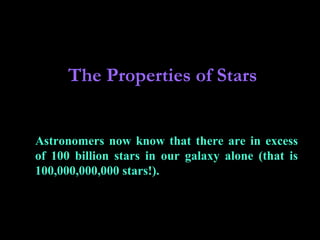
Properties of Stars: Measuring Distances & Determining Colors
- 1. The Properties of Stars Astronomers now know that there are in excess of 100 billion stars in our galaxy alone (that is 100,000,000,000 stars!).
- 2. What are stars? • How can we determine anything about them? • How come some are brighter than others? • How far away are these stars from us? • How can we use only “observation” of stellar light to know the nature of these objects so remote that their light can take years, centuries, maybe even millennia to reach us?
- 3. Stars are remote: Nearest star? Sun – 93,000,000 miles away from earth Next closest? 24 trillion miles away? Proxima Centauri! (Not alpha Centauri!)
- 4. Stellar Parallax Measuring distances to stars: - The most straightforward way of measuring distance is using an effect that we ourselves use everyday to judge distances to the objects around us. Parallax. Parallax is used to measure the distances to some nearby stars. Most other stars are so far away that observing a star from opposite sides of the Earth will produce a parallax angle much, much too small to detect.
- 6. Apparent Position in June of the star against the background stars. Apparent Position in December of the star against the background stars.
- 7. Earth Sun star d Background Stars ρ in parsecs 1 d= ρ in A.U. 206,265 d= ρ The farther the object, the smaller the parallax angle (ρ). ρ is measured in seconds of arc.
- 8. Making a point Tycho Brahe, Copernicus, & Ptolemy failed to measure stellar parallax of any stars because the parallax angles are so very small. (Closest star = Proxima Centauri = 0.772 arcsec = 1.30 parsecs distant! The parallax of Proxima Centauri is comparable to the angular diameter of a dime seen from a distance of 2 miles.)
- 9. Does anything bother you? A question you might be wondering about? Stellar parallax is the “apparent” motion of stars caused by the Earth’s orbital motion around the Sun. But, stars are not fixed objects and they too do move through space. As a result, stars change their positions in the sky over time.
- 10. How Bright?
- 11. Stellar Magnitude Scale Brightness of Stars: Hipparchus “Magnitude Scale” (2100 years ago) – This was done with naked-eye observations. The smaller the magnitude the brighter. (Negative numbers too!) The larger the magnitude the dimmer. He accomplished this by picking a standard star (Vega 0.0) and assigning this star as the common standard by which to compare.
- 12. Starlight, StarBRIGHT? Intrinsic Brightness: Magnitude Absolute Visual (Mν ) – magnitude the star would have if it was 10 parsecs away by standard. Apparent Brightness: Apparent Visual Magnitude (m) – magnitude the star appears to have. This quantity depends on the distance the star is away from us.
- 13. Magnitude Quantification: 1.0 step in magnitude 2.512 times in brightness 2.0 steps in magnitude brightness (2.512)2 = 6.31 times in 3.0 steps in magnitude brightness (2.512)3 = 15.85 times in 4.0 steps in magnitude brightness 5.0 steps in magnitude brightness …… … … (2.512)4 (2.512)5 … = 39.82 times in = 100.0 times in … …
- 14. What can we learn from apparent and absolute magnitudes? How about distance! If we compare the absolute to what apparent brightness a star has we can then surmise the distance the star must be located. The result is given by; m – Mv = - 5 + 5 log(d)
- 15. The Colors of Stars
- 18. Colorful Information Hey, what is going on here? Well, remember blackbody radiation? The hotter the object the “brighter” and the shorter (“bluer”) the wavelength at which most of the energy is emitted. The cooler the object the “dimmer” and longer (“redder”) the wavelength at which most of the energy is emitted. A star’s color depends (photospheric) temperature. on its surface
